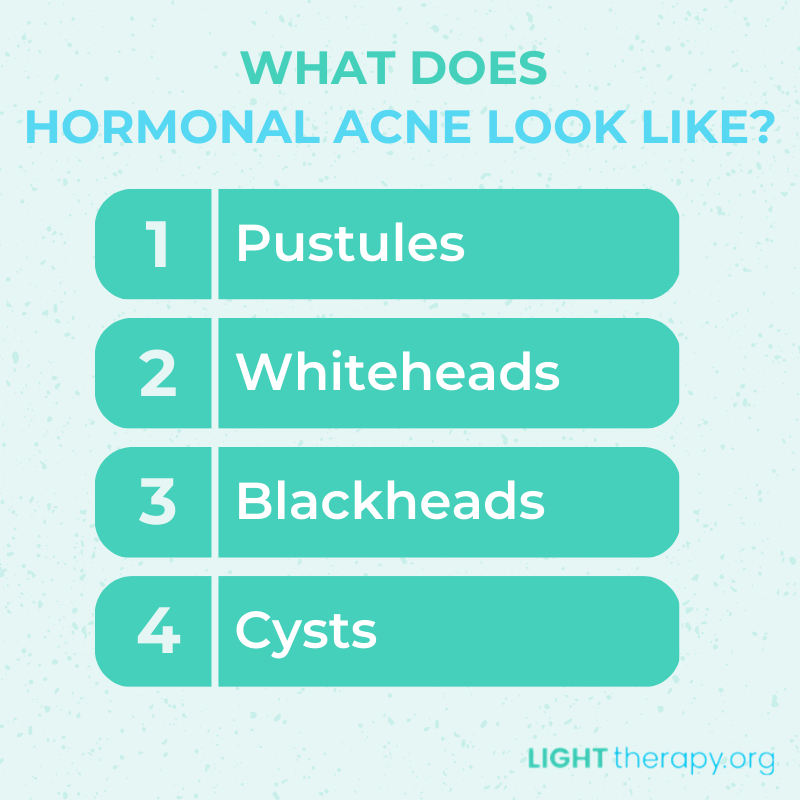How Light Therapy Helps Hormonal Acne
Hormonal fluctuations and imbalances can be a nightmare.
Hormonal issues often cause anxiety, depression, fatigue, and hot flashes. You may also notice a change in your weight, muscle mass, body hair, and, in extreme cases, fertility.
If you’re experiencing any of these symptoms, you may need intervention from a medical professional — but there’s one common symptom we haven’t listed yet that you can tackle on your own: hormonal acne.
Read on to learn a modern way to take control of your complexion with light therapy for hormonal acne.
What Is Hormonal Acne?
Before we discuss light therapy for hormonal acne, let’s look at hormonal acne itself — what it is, why it forms, and how it’s different from the acne most people fought as a teen.
Hormonal acne appears in people aged 20–50. It can take multiple forms, including:
- Pustules
- Whiteheads
- Blackheads
- Cysts
Hormonal acne is primarily caused by overactive sebaceous glands. These glands, found all over the body except for the palms of the hands and soles of the feet, secrete an oil called sebum. The sebaceous glands attach to hair follicles, the tiny pores that grow hair all over your body. From there, the sebum should make its way up and out of the pore to hydrate the surface of your skin.
When there’s too much sebum, the oil becomes trapped in pores, never making it to the surface of the skin. There, it mixes with dirt and debris (including dead skin cells), resulting in whiteheads or blackheads. When acne-causing bacteria enters the mix, the body’s immune system reacts by attacking the bacteria, leading to inflammation, swelling, and pimples.
Anything that disrupts your natural hormone levels can trigger hormonal acne, including chronic stress, sleep deprivation, preexisting health conditions, your phase of life, and even some medical treatments. A few examples include:
- Menstruation
- Menopause
- Polycystic ovary syndrome (PCOS)
- Testosterone treatments
- Steroids
Like other types of acne, hormonal acne can appear anywhere on body where pores exist, but it most commonly appears on the bottom half of the face around the cheeks, jawline, and chin. You may also see hormonal acne on your upper back, shoulders, chest, and neck.
Now that you understand what causes hormonal acne, let’s explore how light therapy for hormonal acne can help.

Light Therapy for Hormonal Acne
Light therapy is a non-invasive treatment for a wide variety of skin conditions, including psoriasis, eczema, certain cancers, and acne. Light therapy uses specific wavelengths of light — blue and red most commonly — to penetrate the skin and improve both visible and invisible symptoms at a cellular level.
When you’re using light therapy for hormonal acne, it’s important to use both blue and red light. Blue light targets and destroys acne-causing bacteria, both within existing pimples to aid healing and on the skin’s surface to prevent new acne from forming. It also reduces inflammation.
Red light, meanwhile, penetrates deeper into the skin, supercharging healthy cells to boost cell turnover and encourage collagen production. The result is better blood flow, reduced inflammation, and a quicker healing process for breakouts.
Perhaps most significantly for hormonal acne, blue and red light therapy work together to regulate the activity of oil-producing cells in the body.
In combination, the powerful duo of blue and red light can help treat existing hormonal acne while inhibiting future breakouts.
What Does the Science Say?
Clinical studies prove light therapy is an effective treatment option for acne in general. However, as of this writing, no studies have been conducted on light therapy for hormonal acne specifically.
Throughout the past few decades, this treatment method has slowly but surely gained recognition in the dermatology world, so it’s likely that a study looking into the effects of light therapy for hormonal acne isn’t far off.
Due to the lack of definitive clinical evidence, you’ll find that some dermatologists recommend light therapy for hormonal acne, while others doubt its effectiveness.
If you’re looking for an effective light therapy device for hormonal acne specifically, independent reviews recommend the LightStim for Acne. The LightStim administers blue and red light in three-minute treatment sessions and can be used in the privacy of your home.
Should You Try Light Therapy for Hormonal Acne?
Now for the big question: Should you try light therapy for hormonal acne?
Truthfully, there’s no downside to giving light therapy a try. It’s a safe option with virtually no side effects. Plus, at-home treatment devices like the LightStim are affordable and easy to use.
However, if you believe an underlying medical condition could be causing your hormonal acne, it’s best to address that root cause with a medical professional. A certified dermatologist can diagnose the cause of your hormonal acne, work with you to tackle it, and recommend additional treatment options for you.